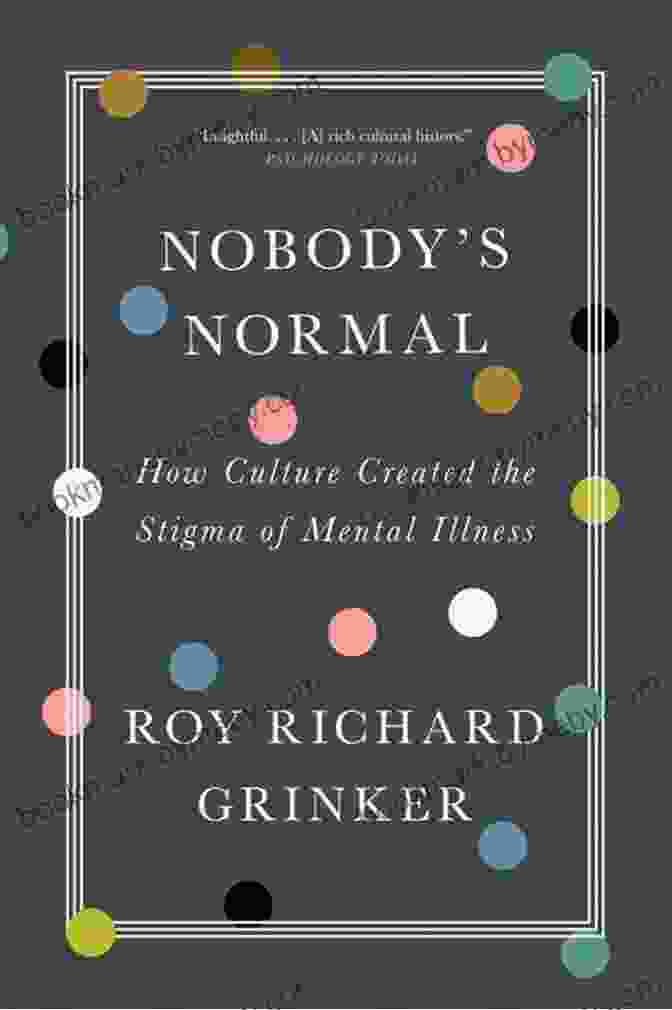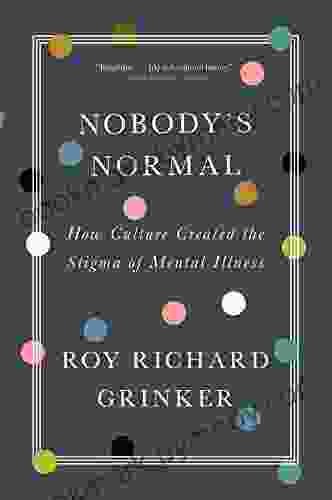Unveiling the Hidden Stigma: How Culture Shapes Our Perception of Mental Illness


Mental illness is a pervasive and often debilitating condition that affects millions of people worldwide. Despite advancements in medical diagnosis and treatment, the stigma associated with mental illness remains a significant barrier to recovery. This stigma can manifest in various forms, ranging from social isolation and discrimination to lack of access to healthcare and support services.
4.7 out of 5
| Language | : | English |
| File size | : | 1159 KB |
| Text-to-Speech | : | Enabled |
| Screen Reader | : | Supported |
| Enhanced typesetting | : | Enabled |
| X-Ray | : | Enabled |
| Word Wise | : | Enabled |
| Print length | : | 435 pages |
The origins of this stigma are complex and deeply ingrained in our cultural beliefs and values. In this comprehensive article, we delve into the ways in which culture has shaped the stigma of mental illness, exploring its historical roots, societal influences, and the resulting consequences for individuals and communities.
Historical Roots
The roots of mental illness stigma can be traced back to ancient times, when psychological distress was often attributed to supernatural forces or moral failings. In the Middle Ages, people with mental illness were often persecuted as witches or sorcerers, and in asylums, they were subjected to inhumane treatment, including physical and psychological abuse.
During the Enlightenment, a more scientific approach to mental illness emerged, but the stigma remained. People with mental illness were still seen as dangerous and irrational, and asylums continued to be places of isolation and confinement.
Societal Influences
In contemporary society, mental illness stigma is perpetuated by a number of factors, including:
- Media representations: The media often portrays people with mental illness as violent, unpredictable, or incapable of functioning in society. This can reinforce stereotypes and contribute to fear and misunderstanding.
- Lack of education: Many people do not have a good understanding of mental illness, its causes, and its treatment options. This can lead to misinformation and prejudice.
- Social norms: In many cultures, there is a strong emphasis on self-reliance and independence. People who experience mental health problems may be seen as weak or lacking in willpower, contributing to feelings of shame and isolation.
Consequences of Stigma
The stigma of mental illness has profound consequences for individuals and communities. It can lead to:
- Delayed diagnosis and treatment: People who fear stigma may avoid seeking help for mental health problems, which can delay diagnosis and treatment and worsen symptoms.
- Limited opportunities: Stigma can limit access to education, employment, and housing for people with mental illness, further isolating them from society.
- Self-stigma: People with mental illness may internalize the negative stereotypes they encounter, leading to low self-esteem, shame, and reduced quality of life.
- Increased risk of suicide: Stigma can contribute to feelings of hopelessness and isolation, which can increase the risk of suicide among people with mental illness.
Breaking the Stigma
Breaking the stigma of mental illness is essential for improving the lives of people who experience it. This can be achieved through:
- Education and awareness: Increasing public understanding of mental illness through educational campaigns and programs can help dispel myths and stereotypes.
- Media responsibility: Media organizations can play a crucial role in reducing stigma by promoting accurate and sensitive representations of mental illness.
- Community support: Creating supportive communities where people with mental illness feel valued and connected can help reduce isolation and stigma.
- Policy changes: Governments can implement policies that promote mental health awareness, reduce discrimination, and ensure equitable access to healthcare and support services.
The stigma of mental illness is a complex and pervasive issue that has its roots in historical and cultural beliefs. It has profound consequences for individuals and communities, limiting access to healthcare, education, and opportunities. By understanding the origins and influences of stigma, we can work towards breaking it down through education, awareness, community support, and policy changes. Together, we can create a society where people with mental illness are treated with dignity, empathy, and respect.
4.7 out of 5
| Language | : | English |
| File size | : | 1159 KB |
| Text-to-Speech | : | Enabled |
| Screen Reader | : | Supported |
| Enhanced typesetting | : | Enabled |
| X-Ray | : | Enabled |
| Word Wise | : | Enabled |
| Print length | : | 435 pages |
Do you want to contribute by writing guest posts on this blog?
Please contact us and send us a resume of previous articles that you have written.
 Book
Book Novel
Novel Page
Page Chapter
Chapter Text
Text Story
Story Genre
Genre Reader
Reader Library
Library Paperback
Paperback E-book
E-book Magazine
Magazine Newspaper
Newspaper Paragraph
Paragraph Sentence
Sentence Bookmark
Bookmark Shelf
Shelf Glossary
Glossary Bibliography
Bibliography Foreword
Foreword Preface
Preface Synopsis
Synopsis Annotation
Annotation Footnote
Footnote Manuscript
Manuscript Scroll
Scroll Codex
Codex Tome
Tome Bestseller
Bestseller Classics
Classics Library card
Library card Narrative
Narrative Biography
Biography Autobiography
Autobiography Memoir
Memoir Reference
Reference Encyclopedia
Encyclopedia Paul Blustein
Paul Blustein J Mccoy
J Mccoy James Barrington
James Barrington Isha Sesay
Isha Sesay J C Amberlyn
J C Amberlyn Jennifer Harshman
Jennifer Harshman Jaak Panksepp
Jaak Panksepp J Michael Holloway
J Michael Holloway Luke F D Marsden
Luke F D Marsden Justine Picardie
Justine Picardie Isaac V D Heard
Isaac V D Heard J T Brannan
J T Brannan Jacob T Schwartz
Jacob T Schwartz John Garofolo
John Garofolo Scott Whitlock
Scott Whitlock J Robert King
J Robert King Viola Shipman
Viola Shipman Jacob Smith
Jacob Smith J Kindheart
J Kindheart Inua Ellams
Inua Ellams
Light bulbAdvertise smarter! Our strategic ad space ensures maximum exposure. Reserve your spot today!

 Stephen FosterIntroducing The Spooky Wheels On The Bus: A Spine-Tingling Adventure for...
Stephen FosterIntroducing The Spooky Wheels On The Bus: A Spine-Tingling Adventure for... Jules VerneFollow ·18.9k
Jules VerneFollow ·18.9k Mario SimmonsFollow ·13.4k
Mario SimmonsFollow ·13.4k Zadie SmithFollow ·18.1k
Zadie SmithFollow ·18.1k Jesse BellFollow ·16.7k
Jesse BellFollow ·16.7k Henry HayesFollow ·19.1k
Henry HayesFollow ·19.1k Joel MitchellFollow ·4.4k
Joel MitchellFollow ·4.4k Curtis StewartFollow ·13.9k
Curtis StewartFollow ·13.9k Benjamin StoneFollow ·19.9k
Benjamin StoneFollow ·19.9k

 Phil Foster
Phil FosterThe Unforgettable Easter: Ramona's Journey of Discovery...
Embark on Ramona's Extraordinary Easter...

 Levi Powell
Levi PowellThe Old City and Mount of Olives: A Journey Through...
Jerusalem, a city etched into the annals of...

 Henry Hayes
Henry HayesThe Clearances: A Journey Through Scotland's Hidden...
In the 18th and 19th...

 Edward Reed
Edward ReedUnravel the Enigmatic 'Path of Bones' with Cassie Quinn...
Step into the...
4.7 out of 5
| Language | : | English |
| File size | : | 1159 KB |
| Text-to-Speech | : | Enabled |
| Screen Reader | : | Supported |
| Enhanced typesetting | : | Enabled |
| X-Ray | : | Enabled |
| Word Wise | : | Enabled |
| Print length | : | 435 pages |














